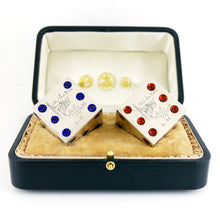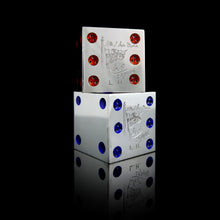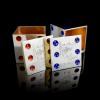Battle of Jutland - Admiral Jellicoe’s Presentation Gift to his Captain of the Fleet, 1916
Adding product to your cart
Each: 4cm (1.6in) x 4cm (1.6in) x 4cm (1.6in)
Provenance: Admiral Sir Lionel Halsey (1872-1949)
Silver with red and blue enamel. A pair of silver salt and pepper shakers in the form of a pair of dice. Each engraved with an Admiral’s flag flying at a masthead and inscribed in facsimile autograph 'H.M.S. Iron Duke' / ‘J.R.J.’ / ’28.11.16’, for the flagship of the Grand Fleet and its Commander-in-Chief Sir John Rushworth Jellicoe, and further engraved ‘L.H.’ for Jellicoe’s Captain of the Fleet, Commodore Lionel Halsey. Gilt interiors and numbered 1 and 2. Maker’s mark of Hamilton & Inches, Princes Street, Edinburgh. Hallmarked Edinburgh 1905. Contained in fitted case. Approx weight 6.7oz
On 24 November 1916 Jellicoe accepted the post of Second Sea Lord following criticism that he had not dealt aggressively enough with Germans at the Battle of Jutland fought on 31 May - 1 June the same year. In Edinburgh on 27 November 1916 he met the former Prime Minister Sir Arthur Balfour, who was then First Lord of the Admiralty in Asquith's Coalition Government, to discuss the mounting crisis of the German submarine campaign. When the meeting concluded it was agreed that Jellicoe would go to Admiralty with his Captain of the Fleet Lionel Halsey as the Fourth Sea Lord. It was perhaps at this point that Jellicoe, or Lady Jellicoe visited the Princes Street premises of Messrs Hamilton & Inches and purchased the present pair of shakers which were duly inscribed with the following day’s date.
Admirals Jellicoe and Halsey were friends of forty years standing. As Commander-in-Chief and Captain of the Fleet they stood together on the bridge of H.M.S. Iron Duke during the Battle of Jutland, which in Winston Churchill’s words was ‘the culminating manifestation of naval forces in the history of the world’. For the instigator of the battle, Admiral Reinhard Scheer, commander of the Imperial German Hochseeflotte, the Battle of Jutland - or, as the Germans called it, the Battle of the Skagerrak - was a roll of the dice to determine the outcome of the decade long naval arms race. While some commentators described Jellicoe’s handling of the Grand Fleet as too cautious in meeting Scheer’s challenge, many appreciate that he made no significant mistakes and correctly deployed his ships in the classic naval warfare tactic of ‘crossing the T’. Moreover, while the public was disappointed that Jellicoe did not deliver a victory on the scale of Trafalgar, Churchill recognised the magnitude of his responsibility by describing him as ‘the only man on either side who could lose the war in an afternoon’ - essentially hinting that Jellicoe's decision to prefer caution was strategically correct. Halsey was thus mentioned in Jellicoe’s Jutland despatch : ’My special thanks are due also to Commodore Lionel Halsey, C.M.G., the Captain of the Fleet, who also assists me in the working of the fleet at sea, and to whose good organisation is largely due the rapidity with which the fleet was fuelled and replenished with ammunition on return to its bases. He was of much assistance to me during the action.’
Jellicoe and Halsey were men of great integrity and both before and after Jutland the two officers had remarkable careers. In July 1918 Halsey stood as godfather to Jellicoe’s son who would become the 2nd Earl Jellicoe and the daring commander of the Special Boat Service during the Second World War. Other godparents were George V and Princess Patricia of Connaught.
Admiral of the Fleet Sir John Rushworth Jellicoe, 1st Earl Jellicoe of Scapa, G.C.B., O.M., G.C.V.O., (1859-1935) entered the navy as a cadet in the training ship H.M.S. Brittannia in 1872. Smaller than Nelson in stature and popularly known as ‘Hellfire Jack’, he commanded a rifle company of Bluejackets at Ismalia during the Egyptian War of 1882. A gunnery specialist, he rose to become a member of the Admiralty's Ordnance Committee in 1897, and in 1900 was captain of the battleship Centurion. He was badly wounded during the Boxer Rebellion at the Battle of Peitsang when the Eight Nation Alliance forced the Chinese out of prepared positions on the road to Peking. He was told he was going to die but confounded the surgeon and chaplain by living. A protege of Admiral Jackie Fisher, Jellicoe worked hard in the run up to the First World War to modernise the navy by advocating the construction of new dreadnoughts and battlecruisers and arguing for important improvements in gunnery. In 1912 he dined with at Potsdam with the Kaiser whose dreams of an east coast invasion of Britain, it was Jellicoe’s responsibility to thwart. In 1914, the First Lord of the Admiralty Winston Churchill ordered Jellicoe to replace the ageing Commander-in-Chief Home Fleet, but, acting as ever in the best interests of the Service, resisted the appointment on the grounds that it would cause tension in the fleet. The order was confirmed by the Admiralty and an awkward hand over of the newly renamed Grand Fleet took place aboard Iron Duke at Scapa.
Admiral Sir Lionel Halsey, G.C.M.G., G.C.V.O., K.C.I.E., C.B., A.D.C., (1872-1949) was the fourth son of Sir Thomas Frederick Halsey, 1st Bart., M.P. He entered the navy as a Britannia cadet in 1885, and served as a Sub-Lieutenant in the Royal Yacht Victoria & Albert II. During the Second Boer War (1899-1902) he commanded H.M.S. Powerful’s dismounted 4.7 inch guns in the protracted defence of Ladysmith. Promoted captain in 1905, he served as Flag Captain to the Commander-in-Chief Australia Station. In 1912 Halsey was given command of the new battlecruiser H.M.S. New Zealand and took the ship on a goodwill tour. At Rotorua he was presented with a sacred Māori war skirt that would bring the wearer good fortune in battle by an venerable chief. The chief the made three prophecies. The first was that the ship would be involved in three actions; that the ship would be hit only once and that no one on board would be killed. The chief asked Halsey whether he would wear the grass skirt in battle. Halsey agreed to do so not thinking he would ever have to honour the promise. On 28 August 1914 H.M.S. New Zealand went into action at Heligoland Bight. Halsey donned the war skirt over his trousers - and the ship came through unharmed. Halsey wore the grass skirt again at Dogger Bank (24 January 1915). Once more the ship came under heavy fire, but remained untouched. In May 1915 when Halsey was appointed Commodore 1st class and Captain of the Fleet in Jellicoe’s flagship Iron Duke, he passed the grass skirt to his successor who wore it at Jutland.
Following promotion to Rear-Admiral and appointment as Fourth Sea Lord in December 1916, Halsey became Third Lord in 1917. In September 1918 he returned to sea in the battlecruiser H.M.A.S. Australia in command of the 2nd Battlecruiser Squadron of the Grand Fleet and was present at the German surrender at Scapa Flow. In November 1920 Halsey began a second career as a courtier was appointed Comptroller and Treasurer to the Prince of Wales. He became a member of the Prince's council in 1920, and accompanied the Prince on his tours to India, Africa and South America. Known to the Prince as the ‘Old Salt’, he took the Prince’s high-spirited antics with good natured forebearance such as on the occasion on board H.M.S. Renown when the Prince lost control of a fire hose and inadvertently soaked Halsey’s cabin. However following a mayoral ball in San Diego at which the future Mrs Simpson was present, he reported disdainfully to George V ‘one has to be extremely careful at these sorts of places where one meets all sorts of conditions of people.’ In 1936 Halsey was dismissed due to his opposition to Wallis Simpson. In 1937, however, he was appointed an extra equerry to George VI and took part in the coronation procession as acting Keeper of the Jewel House. Halsey breathed his last at Biggleswade, Bedfordshire in 1949.








